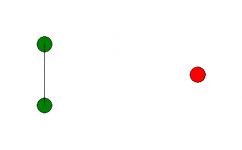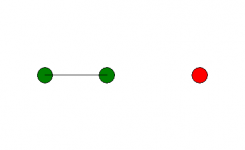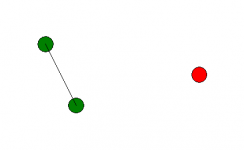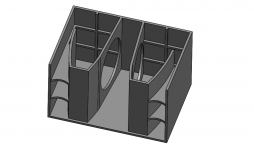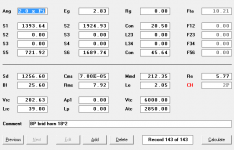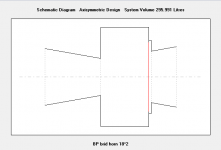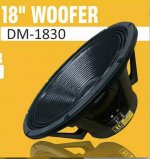Hi just a guy,
The power response predictions for distance-separated combined outputs are now more accurate. The phase response and impulse response results for individual and combined outputs are also now more accurate. The improvements are all due to the sterling work of bolserst. In the case of the impulse response, he found ways of improving the original algorithm developed by Jean-Michel Le Cléac'h. Just understanding what Jean-Michel had done in the first place, was a very impressive achievement, in my book.
If bolserst reads this thread, he is most welcome to add any further details on the changes, as he sees fit.
You are not wrong there... The gentleman is a genius, and I have already told him so .
.
"We aim to please" .
.
Kind regards,
David
If you want to say a few words about Change 2 and how it changes things I would be interested in hearing about it.
The power response predictions for distance-separated combined outputs are now more accurate. The phase response and impulse response results for individual and combined outputs are also now more accurate. The improvements are all due to the sterling work of bolserst. In the case of the impulse response, he found ways of improving the original algorithm developed by Jean-Michel Le Cléac'h. Just understanding what Jean-Michel had done in the first place, was a very impressive achievement, in my book.
If bolserst reads this thread, he is most welcome to add any further details on the changes, as he sees fit.
I've found bolserst to really know what he's talking about
You are not wrong there... The gentleman is a genius, and I have already told him so
Thanks for all this hard work, the new Lossy Le tool makes me very happy.
"We aim to please"
Kind regards,
David
A 'senior moment' perhaps?
Hi GM,
I sincerely hope not!
My excuse is 'testing fatigue' coupled with 'temporary insanity'...
Not helping things currently is a noisy land-line phone and an ADSL Internet connection that keeps dropping out. The fault is intermittent and proving very difficult to identify and isolate. All I know for sure at this stage is that the problem is not with my equipment.
Very distracting...
Kind regards,
David
The power response predictions for distance-separated combined outputs are now more accurate. The phase response and impulse response results for individual and combined outputs are also now more accurate.
I overlooked including perhaps the most significant change, at least as far as the user is concerned. When considering combined outputs, the path length input parameter now refers to the separation distance between the two outputs, not the difference in the path lengths from the two outputs to the reference listening point. All values are now positive, whereas previously it was possible to specify either a positive or a negative value.
This means for example, that for a bass-reflex loudspeaker having the driver at the top of the enclosure front panel and the port at the bottom, the path length value is now the distance from the centre point of the direct radiating driver diaphragm to the centre point of the port outlet. In the past, a zero path length (difference) would have been specified for such a system if the distances from the two outputs to the listener were the same.
In the three schematics attached, the green circles represent the two outputs, the red circle is the listening point, and the straight line connecting the two green circles is the path length value specified by the user. For co-located sources, the path length value is zero.
Attachments
I need calculation software for smps resonant supply's can I use Octave for that?
thanks
For some reason diyaudio.com has not been sending me update emails.
And to answer your question. I do not know.
If your software was written for Matlab it could possibly run in Octave.
Thanks for your kind words, although I would have to say that I think it is Jean-Michel that is the genius.…The power response predictions for distance-separated combined outputs are now more accurate. The phase response and impulse response results for individual and combined outputs are also now more accurate. The improvements are all due to the sterling work of bolserst. In the case of the impulse response, he found ways of improving the original algorithm developed by Jean-Michel Le Cléac'h. Just understanding what Jean-Michel had done in the first place, was a very impressive achievement, in my book.
He figured out a way to perform IFT(inverse Fourier Transform) on Log spaced frequency data. With traditional IFFT, you would need to use 65,536 data points to get the same impulse resolution as he got with the 533 used in Hornresp. I didn’t even realize this was possible.
@JAG,
What led to the impulse improvement, was noticing that exporting the impulse *.wav file into other software like ARTA or REW in some cases did not result in the same SPL and phase response as the source data from Hornresp. Digging into his archives DMcBean realized he had noticed this before and that it was something Jean-Michel had implemented to avoid pre-impulse “noise” ruining the impulse plot altogether, and was still searching for the cause. Long story short, looking at the code with the benefit of fresh eyes I noticed where the hiccup was. So, impulse data exported in the *.wav file now matches the SPL and phase response in all cases.
The improvement in power response calculation for the separated sources of compound horns, vented enclosures, etc… also came about in an unexpected way. I was trying to reconcile differences I was getting between Hornresp and a slow, tedious, brute force summation of radiated pressure over a sphere surrounding the two sources. The results I was getting were what DMcBean desired(ie true power response), but there was no easy way to implement so the previous Hornresp method was the next best thing. However, I am not one to give up easily and eventually was able to derive a fairly simple expression that matched the brute force summations exactly. Of course just days after that, google uncovered a paper I had somehow previously missed which contained the same expression. If interested, see chapter 3 here: http://web-files.ait.dtu.dk/fjac/p_home_page/notes/Radiation.pdf It still puzzles me that this method is not contained in any of the better know acoustic texts.
In any case, the end result is that the power response for combined sources is now completely consistent with the power response for the individual sources no matter what the separation distance.
DMcBean also desired that the phase response for both individual and combined sources should follow the methodology of Leach, Beranek, etc…a worthy goal. I had noticed that previous versions of Hornresp had a phase discrepancy at higher frequencies which was dependent on the size of the radiator. After a few missteps, we were able to implement a consistent corrected phase calculation for both individual and combined sources.
I'm sure this is all probably more than you wanted to know, but you did ask
I'm sure this is all probably more than you wanted to know, but you did ask
Hi bolserst,
Many thanks for providing such comprehensive additional information for JAG, and thanks again for your extremely valuable contribution to Hornresp.
Kind regards,
David
Hello david
I need your help. You have a way to use eq with active cross to run concurrently. Please introduce me.
Thank you David
Hi Piyapong38,
The Equaliser and Active filters in the Hornresp Filter Wizard operate separately, and cannot be used together. You can run either one or the other, but not both concurrently.
Kind regards,
David
Would it be best to make a new thread if I need some more in-depth help with making a 'loud' horn? I understand that hornresp is awesome for it and such, and I've done everything, but I can't wrap my head around how to actually 'fold' something or alike.
What I'm looking to do is make a horn bass speaker that will be loud in open areas where my 12 Inch Home Theater sub can't make much sound pressure.
I'm thinking of the DC300*8 12" Classic Woofer.
new thread/pm's, yay or nay?
What I'm looking to do is make a horn bass speaker that will be loud in open areas where my 12 Inch Home Theater sub can't make much sound pressure.
I'm thinking of the DC300*8 12" Classic Woofer.
new thread/pm's, yay or nay?
If huge is anything like 3x the size of my TLine Logitech, then that's fine. Just nothing taller than my chin. :')
Does it help to knock out 40hz from the 'good response' situation in order to make it easier? i'm using this Classic woofer because the PA woofers are all so expensive and I don't see the huge improvement in sound over a normal one, besides from less excursion and more power handling.
I'll make a new thread upcoming week, and see what I can do myself too.
Thanks!
Does it help to knock out 40hz from the 'good response' situation in order to make it easier? i'm using this Classic woofer because the PA woofers are all so expensive and I don't see the huge improvement in sound over a normal one, besides from less excursion and more power handling.
I'll make a new thread upcoming week, and see what I can do myself too.
Thanks!
Hello david
I'm not sure about this cabinet. What do I need to use the On the window hornresp.Especially the part is horn Speaker Pages.I'm not sure what value to use.
I'm not sure about this cabinet. What do I need to use the On the window hornresp.Especially the part is horn Speaker Pages.I'm not sure what value to use.
Attachments
Hello david
I'm not sure about this cabinet. What do I need to use the On the window hornresp.Especially the part is horn Speaker Pages.I'm not sure what value to use.
Hi Piyapong38,
While not a perfect match, the Hornresp Compound Horn (CH) simulation model seems to be the most suitable one to use, as it is the arrangement option that most closely specifies the design layout of the cabinet shown. When you say "not sure what value to use", it is not clear to me what parameter you are referring to. Also, I don't understand what you mean by "the On the window hornresp" and "the part is horn Speaker Pages".
Kind regards,
David
This speakerHi Piyapong38,
While not a perfect match, the Hornresp Compound Horn (CH) simulation model seems to be the most suitable one to use, as it is the arrangement option that most closely specifies the design layout of the cabinet shown. When you say "not sure what value to use", it is not clear to me what parameter you are referring to. Also, I don't understand what you mean by "the On the window hornresp" and "the part is horn Speaker Pages".
Kind regards,
David
Attachments
This speaker
Hi Piyapong38,
I'm still not certain what it is that you are asking, but the Hornresp input parameter values to use for the KTH DM-1830 driver are as follows:
Sd = 1195.00
Cms = 8.42E-05
Mmd = 212.31
Re = 5.50
Bl = 24.00
Rms = 6.45
Le = 2.19
Kind regards,
David
The Equaliser and Active filters in the Hornresp Filter Wizard operate separately, and cannot be used together.
The next update will allow the active filter accessed from the input parameters window, and the parametric equalisers in the Filter Wizard, to be used together.
Hello David,
As always, thanks for the hornresp.
I'd like to suggest a simple feature to be added at all input cells. Currently we need to specify a value for them and I'd like to be able to specify an equation, is it possible?
Example (like excell sheet):
current: S1 = 440
Proposal: S1 = 55*8
Using equation it would be fast to change some parameters and see the effect like the cab width.
At least simple math would not be hard to implement like: + - / * ^n
Regards
As always, thanks for the hornresp.
I'd like to suggest a simple feature to be added at all input cells. Currently we need to specify a value for them and I'd like to be able to specify an equation, is it possible?
Example (like excell sheet):
current: S1 = 440
Proposal: S1 = 55*8
Using equation it would be fast to change some parameters and see the effect like the cab width.
At least simple math would not be hard to implement like: + - / * ^n
Regards
- Home
- Loudspeakers
- Subwoofers
- Hornresp
